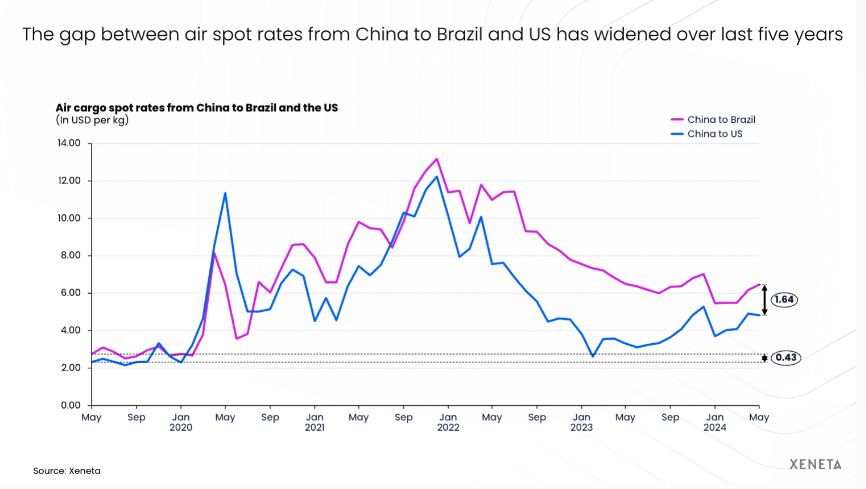Capacity on the China-Latin America trade has been coming under pressure due to soaring demand and the trend is expected to continue into the peak season.
A market analysis from Xeneta airfreight analyst Wenwen Zhang shows that air cargo spot rates from China to Latin America have more than doubled from May 2019 to May 2024.
The data provider’s figures show that spot rates from China to Brazil reached $6.46 per kg in May compared with less than $3 per kg in the same month in 2019.
Zhang said this is $1 per kg more than the rate from China to the US.
She said there are two reasons for the increase in rates: rising demand fuelled by e-commerce and the difficulty in adding extra capacity to the market.
“On the demand side, the phenomenal rise of e-commerce, alongside high-tech manufactured goods, has been the main driver behind increasing air cargo rates from China to Latin America,” Zhang said.
“China’s supportive governmental policies, such as ‘Silk Road e-commerce’, have facilitated companies like Shein and AliExpress to expand rapidly over the past year, sending packages directly from warehouses in China to Brazil and Mexico.”
On the capacity side, the distance between the two regions means there aren’t too many direct passenger operations – a flight from Shenzhen to Mexico City takes 16 hours, she points out.
“Therefore, air cargo heading from China to Latin America tends to move on multi-stop flights via other regions, such as North America, Europe, or the Middle East,” Zhang said.
“Complicating matters further are the ongoing disruptions in the Red Sea and the slow recovery of belly capacity between China and North America, squeezing the additional capacity for Latin America.
“All this may mean a constrained capacity between China and Latin America is here to stay and shippers’ concerns regarding the peak season may be well founded.”
She added that demand performance on other trade lanes can eat into potential China-Latin America capacity.
“For example, given the corridor’s intricate network of routes, a potential increase in e-commerce demand from China to the US could trigger a ripple effect impacting the China to Latin America market – even if demand from China to Latin America remains constant,” writes Zhang.
“This highly complex situation means it will not be an easy conversation between shippers and freight forwarders to negotiate rates ahead of a busy year-end peak season.”
Looking ahead, there have been moves to limit de minimis imports (tax-free imports for low-value shipments). These are not expected to impact the likes of Shein and Temu in the short term but could lead to them setting up China-US supply chains via Latin America.
Worsening box line disruption to have limited air cargo impact
The post China-Latam air cargo capacity under pressure appeared first on Air Cargo News.



